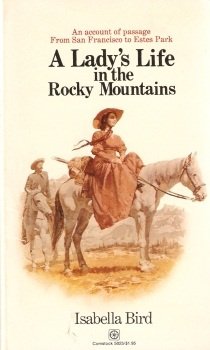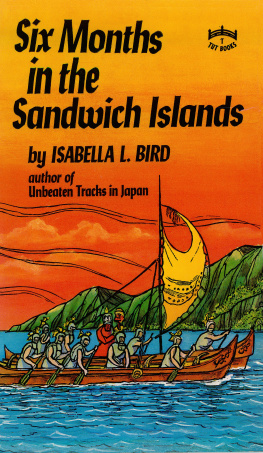Isabella L. Bird
A Ladys Life in the Rocky Mountains
 Estes Park
Estes Park Title-page
Title-pageTo My Sister,
to whom
these letters were originally written,
they are now
affectionately dedicated.
THESE letters, as their style sufficiently indicates, were written without the remotest idea of publication. They appeared last year in the Leisure Hour at the request of its editor, and were so favourably received that I venture to present them to the public in a separate form, as a record of very interesting travelling experiences, and of a phase of pioneer life which is rapidly passing away.
I. L. B.
October 21, 1879.
Note to the second edition
FOR the benefit of other lady travellers, I wish to explain that my Hawaiian riding dress is the American Lady's Mountain Dress, a half-fitting jacket, a skirt reaching to the ankles, and full Turkish trousers gathered into frills falling over the boots, a thoroughly serviceable and feminine costume for mountaineering and other rough travelling, as in the Alps or any other part of the world. I add this explanation to the prefatory note, together with a rough sketch of the costume in the Times of November 22d.
I.L.B.
November 27, 1879.
Note to the third edition
IN consequence of the unobserved omission of a date to my letters having been pointed out to me, I take this opportunity of stating that I travelled in Colorado in the autumn and early winter of 1873, on my way to England from the Sandwich Islands. The letters are a faithful picture of the country and state of society as it then was; but friends who have returned from the West within the last six months tell me that things are rapidly changing, that the frame house is replacing the log cabin, and that the footprints of elk and bighorn may be sought for in vain on the dewy slopes of Estes Park.
I.L.B.
January 16, 1880.
Lake Tahoe Morning in San Francisco Dust A Pacific mail-train Digger Indians Cape Horn A mountain hotel A pioneer A Truckee livery stable A mountain stream Finding a bear Tahoe.LAKE TAHOE, September 2.
I have found a dream of beauty at which one might look all one's life and sigh. Not lovable, like the Sandwich Islands, but beautiful in its own way! A strictly North American beauty snow-splotched mountains, huge pines, red-woods, sugar pines, silver spruce; a crystalline atmosphere, waves of the richest color; and a pine-hung lake which mirrors all beauty on its surface. Lake Tahoe is before me, a sheet of water twenty-two miles long by ten broad, and in some places 1,700 feet deep. It lies at a height of 6,000 feet, and the snow-crowned summits which wall it in are from 8,000 to 11,000 feet in altitude. The air is keen and elastic. There is no sound but the distant and slightly musical ring of the lumberer's axe.
It is a weariness to go back, even in thought, to the clang of San Francisco, which I left in its cold morning fog early yesterday, driving to the Oakland ferry through streets with side-walks heaped with thousands of cantaloupe and water-melons, tomatoes, cucumbers, squashes, pears, grapes, peaches, apricots all of startling size as compared with any I ever saw before. Other streets were piled with sacks of flour, left out all night, owing to the security from rain at this season. I pass hastily over the early part of the journey, the crossing the bay in a fog as chill as November, the number of "lunch baskets," which gave the car the look of conveying a great picnic party, the last view of the Pacific, on which I had looked for nearly a year, the fierce sunshine and brilliant sky inland, the look of long rainlessness, which one may not call drought, the valleys with sides crimson with the poison oak, the dusty vineyards, with great purple clusters thick among the leaves, and between the vines great dusty melons lying on the dusty earth. From off the boundless harvest fields the grain was carried in June, and it is now stacked in sacks along the track, awaiting freightage. California is a "land flowing with milk and honey." The barns are bursting with fullness. In the dusty orchards the apple and pear branches are supported, that they may not break down under the weight of fruit; melons, tomatoes, and squashes of gigantic size lie almost unheeded on the ground; fat cattle, gorged almost to repletion, shade themselves under the oaks; superb "red" horses shine, not with grooming, but with condition; and thriving farms everywhere show on what a solid basis the prosperity of the "Golden State" is founded. Very uninviting, however rich, was the blazing Sacramento Valley, and very repulsive the city of Sacramento, which, at a distance of 125 miles from the Pacific, has an elevation of only thirty feet. The mercury stood at 103 degrees in the shade, and the fine white dust was stifling.
In the late afternoon we began the ascent of the Sierras, whose sawlike points had been in sight for many miles. The dusty fertility was all left behind, the country became rocky and gravelly, and deeply scored by streams bearing the muddy wash of the mountain gold mines down to the muddier Sacramento. There were long broken ridges and deep ravines, the ridges becoming longer, the ravines deeper, the pines thicker and larger, as we ascended into a cool atmosphere of exquisite purity, and before 6 P.M. the last traces of cultivation and the last hardwood trees were left behind.
At Colfax, a station at a height of 2,400 feet, I got out and walked the length of the train. First came two great gaudy engines, the Grizzly Bear and the White Fox, with their respective tenders loaded with logs of wood, the engines with great, solitary, reflecting lamps in front above the cow guards, a quantity of polished brass-work, comfortable glass houses, and well-stuffed seats for the engine-drivers. The engines and tenders were succeeded by a baggage car, the latter loaded with bullion and valuable parcels, and in charge of two "express agents." Each of these cars is forty-five feet long. Then came two cars loaded with peaches and grapes; then two "silver palace" cars, each sixty feet long; then a smoking car, at that time occupied mainly by Chinamen; and then five ordinary passenger cars, with platforms like all the others, making altogether a train about 700 feet in length.
The platforms of the four front cars were clustered over with Digger Indians, with their squaws, children, and gear. They are perfect savages, without any aptitude for even aboriginal civilization, and are altogether the most degraded of the ill-fated tribes which are dying out before the white races. They were all very diminutive, five feet one inch being, I should think, about the average height, with flat noses, wide mouths, and black hair, cut straight above the eyes and hanging lank and long at the back and sides. The squaws wore their hair thickly plastered with pitch, and a broad band of the same across their noses and cheeks. They carried their infants on their backs, strapped to boards. The clothing of both sexes was a ragged, dirty combination of coarse woolen cloth and hide, the moccasins being unornamented. They were all hideous and filthy, and swarming with vermin. The men carried short bows and arrows, one of them, who appeared to be the chief, having a lynx's skin for a quiver. A few had fishing tackle, but the bystanders said that they lived almost entirely upon grasshoppers. They were a most impressive incongruity in the midst of the tokens of an omnipotent civilization.





 Estes Park
Estes Park Title-page
Title-page